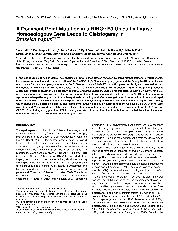摘要
In the allopolyploid Brassica napus, we obtained a petal-closed flower mutation by ethyl methanesulfonate mutagenesis. Here, we report cloning and characterization of the Bn-CLG1A (CLG for cleistogamy) gene and the Bn-clg1A-1D mutant allele responsible for the cleistogamy phenotype. Bn-CLG1A encodes a RINGv E3 ubiquitin ligase that is highly conserved across eukaryotes. In the Bn-clg1A-1D mutant allele, a C-to-T transition converts a Pro at position 325 to a Leu (P325L), causing a dominant mutation leading to cleistogamy. B. napus and Arabidopsis thaliana plants transformed with a Bn-clg1A-1D allele show cleistogamous flowers, and characterization of these flowers suggests that the Bn-clg1A-1D mutation causes a pronounced negative regulation of cutin biosynthesis or loading and affects elongation or differentiation of petal and sepal cells. This results in an inhibition or a delay of petal development, leading to folded petals. A homoeologous gene (Bn-CLG1C), which shows 99.5% amino acid identity and is also constitutively and equally expressed to the wild-type Bn-CLG1A gene, was also identified. We showed that P325L is not a loss-of-function mutation and did not affect expression of Bn-clg1A-1D or Bn-CLG1C. Our findings suggest that P325L is a gain-of-function semidominant mutation, which led to either hyper- or neofunctionalization of a redundant homoeologous gene.
- 出版日期2012-12
